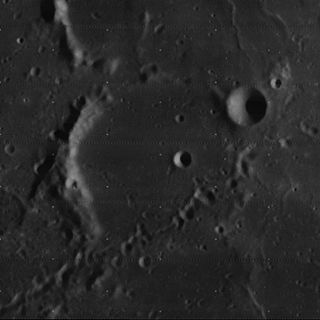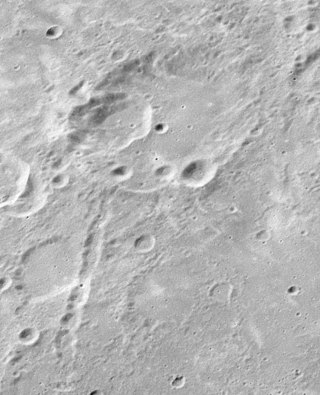
Humboldt is a large lunar impact crater that is located near the eastern limb of the Moon. Due to foreshortening this formation has an extremely oblong appearance. The actual shape of the crater is an irregular circle, with a significant indentation along the southeastern rim where the prominent crater Barnard intrudes. To the north-northwest of Humboldt is the large crater Hecataeus. Phillips is attached to the western rim. The rim of Humboldt is low, worn, and irregular in outline. The central peak forms a range on the crater floor. The floor surface contains a network of rilles forming a pattern of radial spokes and concentric arcs. There are also some dark patches located near the walls to the northeast, northwest, and southeast. There is a chain of craters leading from the northwest crater rim to a distance almost as long as the crater is wide. This formation is designated Catena Humboldt. Due to its location near the lunar limb, little detail was known about this crater until it was photographed by orbiting spacecraft.

Tacitus is a lunar impact crater located to the northwest of the crater Catharina, at the northern extension of the Rupes Altai ridge line. It was named after the 1st century Roman historian and writer Tacitus. Directly west is the crater Almanon, and to the northeast is Cyrillus. To the southeast of Tacitus is a long chain of craters named the Catena Abulfeda. This chain runs to the northwest from the eastern edge of the Rupes Altai, continuing for over 200 kilometers.

Abulfeda is a lunar impact crater located in the central highlands of the Moon. To the northeast is the crater Descartes, and to the south-southeast is Almanon. To the north is the crater Dollond. A chain of craters named the Catena Abulfeda runs between the southern rim of Abulfeda and the north rim of Almanon, then continues for a length of 210 kilometers across the Rupes Altai. The crater was named for 14th century Kurdish historian Ismael Abul-fida.

Cardanus is a lunar impact crater that is located in the western part of the Moon, in the western part of the Oceanus Procellarum. Due to its location the crater appears very oval because of foreshortening, and it is viewed almost from the side.

Descartes is a heavily worn lunar impact crater that is located in the rugged south-central highlands of the Moon. To the southwest is the crater Abulfeda. It is named after the French philosopher, mathematician and physicist René Descartes.

Almanon is a lunar impact crater that lies in the rugged highlands in the south-central region of the Moon. It was named after Abbasid Caliph and astronomer Al-Ma'mun. It is located to the south-southeast of Abulfeda, and to the north-northeast of the smaller crater Geber. The crater chain designated Catena Abulfeda forms a line between the south rim of Abulfeda and the north rim of Almanon, continuing for a length of about 210 kilometers to the Rupes Altai scarp.

Anděl is a lunar impact crater that lies in the rugged central highlands of the Moon. It was named after the Czech astronomer Karel Anděl. Nearby craters of note include Abulfeda to the south-southeast and Descartes to the east-southeast. About 85 kilometres to the east-northeast of the outer rim is the landing site of the Apollo 16 mission.

Davy is a small lunar impact crater that is located on the eastern edge of the Mare Nubium. It was named after British physicist Humphry Davy. It overlies the lava-flooded remains of the satellite crater Davy Y to the east, a formation which contains a crater chain designated Catena Davy. To the southeast of Davy is the prominent crater Alphonsus.

Boole is a lunar impact crater that lies along the northwestern limb of the Moon, to the northwest of the crater Gerard. At this location it is viewed nearly from the side, and is very oblong in shape due to foreshortening. The crater formation is nearly circular, however, with a wide inner wall that has been worn and rounded due to subsequent impacts. It is named after George Boole.

Gould is the remnant of a lunar impact crater formation that lies in the midst of the Mare Nubium, in the southwest quadrant of the Moon. It was named after American astronomer Benjamin A. Gould. It is located to the east-northeast of the prominent crater Bullialdus, and south of the crater remnant Opelt.

Drygalski is a large lunar impact crater that lies along the southern limb of the Moon. It partly overlies the crater Ashbrook to the west on the far side of the Moon. Just to the north of Drygalski is the smaller Boltzmann. The location of this crater restricts its observation from the Earth, and even under conditions of favorable libration it is viewed from the edge. It is only illuminated by the Sun at an oblique angle, and it lies close to the south polar craters that are permanently shielded from sunlight.

Mendeleev is a large lunar impact crater that is located on the far side of the Moon, as seen from the Earth. The southern rim of this walled plain just crosses the lunar equator. Intruding into the eastern rim of Mendeleev is the crater Schuster. Nearly on the opposite side, the smaller Hartmann intrudes into west-southwestern rim.

Gibbs is a lunar impact crater that lies near the eastern limb of the Moon. It is situated less than a crater diameter to the northeast of the larger crater Hecataeus. The crater chain Catena Humboldt passes to the south of Gibbs, following a line to the northeast. Due to its proximity to the limb, this crater appears foreshortened when viewed from the Earth, and visibility is subject to libration.

Dziewulski is a lunar impact crater on the far side of the Moon. It lies between the craters Edison to the north and Popov to the south. The outer rim of this crater has been considerably worn by impacts, particularly along the southwest quadrant where the satellite crater Dziewulski Q overlies the rim and the interior floor. The northern rim is also heavily disrupted, and several small crater lie along the southeast rim. The interior floor and surrounding terrain has been resurfaced.

Harriot is a lunar impact crater that is located on the far side of the Moon from the Earth. It lies just to the north of the much larger crater Seyfert. To the northeast of Harriot is the crater Cantor. About one and a half crater diameters to the north of Harriot is the eastern end of a crater chain named Catena Sumner. This feature continues to the west-northwest for a distance of 247 km, passing to the north of the crater Sumner.

Gregory is a lunar impact crater on the far side of the Moon. It is named after the 17th century Scottish astronomer and mathematician James Gregory. It is located to the southeast of the crater Ibn Firnas, and north-northeast of Bečvář. About one crater diameter to the north is the smaller Morozov.

Kolhörster is a lunar impact crater that is located on the moon's far side. It lies about a crater-diameter to the south-southeast of the crater Kamerlingh Onnes, and to the northeast of the crater Michelson. To the south of Kolhörster is an area marked with crater chains formed from secondary impacts during the creation of the Mare Imbrium impact basin. About one crater-diameter to the southeast is the Catena Leuschner crater chain, while further to the south is Catena Michelson.

Kurchatov is a lunar impact crater that is located on the Moon's far side. It is just to the southwest of the crater Wiener, and farther to the southeast of Bridgman. A couple of crater diameters to the south of Kurchatov is the northern edge of the Mare Moscoviense.

Michelson is a crater on the far side of the Moon. It lies along the northeastern outer rim of the huge walled plain Hertzsprung, and to the southwest of the crater Kolhörster.

Prager is an impact crater on the Moon's far side. It was named after German-American astronomer Richard Prager. It is located just to the northeast of the crater Love. Farther to the south-southeast lies Lane. To the north of this crater and leading away to the northwest is a crater chain that has been designated Catena Gregory.




















